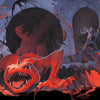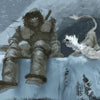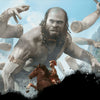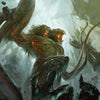What Is the Best Way to Play D&D: Minis & Terrain or Theater of the Mind?
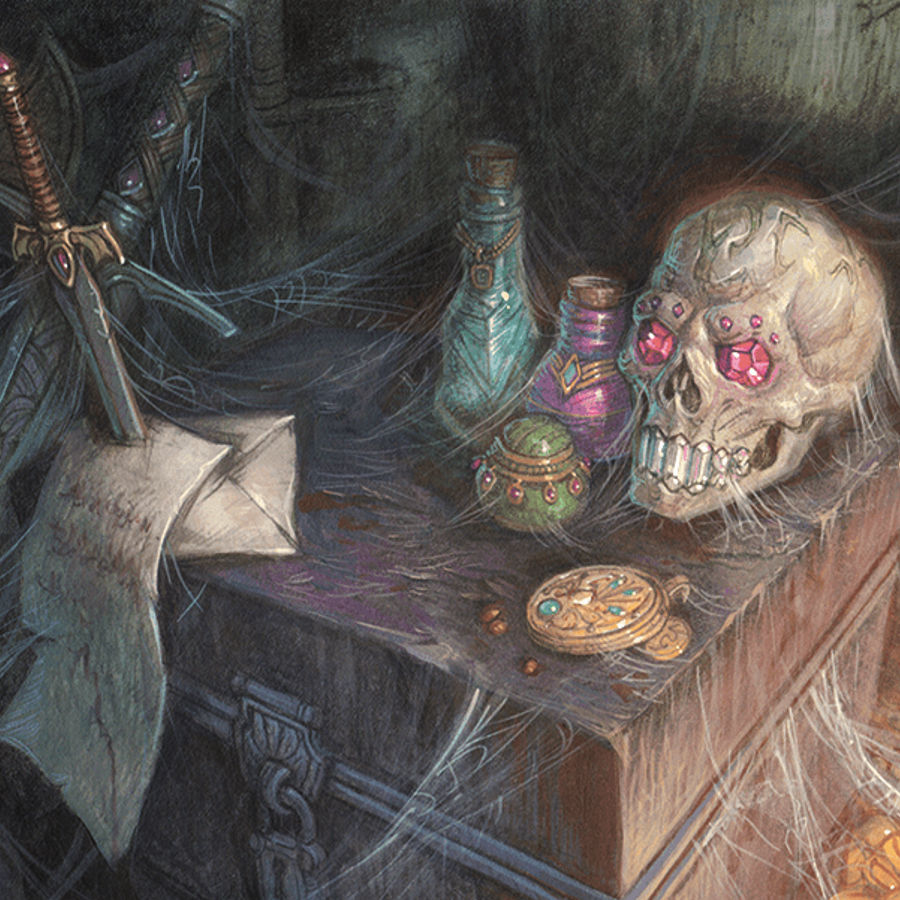
Written by Luke Hart
Do you ever wonder the best way to run D&D, Pathfinder 2, or whatever tabletop RPG you happen to be into? When it comes to a physical representation of gameplay, you have four options: Theater of the Mind, Universal Dungeon Terrain, Battle Mats, and Full-Blown, Detailed Terrain. So, which of these is best for your game?
Watch or listen to this article by clicking the video below.
#1 Theater of the Mind
If you’re not familiar with Theater of the Mind, it’s a method of play where combat takes place in the game master’s and players’ minds. There are no grids; there are no miniatures. Everything is in your head. Naturally, Theater of the Mind can be used for both in-person and online play.
A huge advantage to this style of play is that it costs nothing and is super portable. That is, of course, assuming you’re able to take your brain with you everywhere you go, which most of us can, even though you do sometimes run into someone who left their brain at home. It does happen.
I have found Theater of the Mind to be a highly immersive experience because it relies so much more on our imaginations than physical combat representations like battle mats or dungeon terrain. This often leads to more engaging and awesome stories. There’s just something about imagining everything in your mind’s eye that elevates the game experience in a particular way for many players.
Furthermore, Theater of the Mind is infinitely flexible and adaptable, especially for game masters. I remember one time when my players went off the beaten path and decided to assault a keep I didn’t have planned out. Because we were using Theater of the Mind, it was fairly easy for me to just describe the castle walls, the guards atop them, the corridors, and the rooms. Sure, I was improvising, but not needing to draw anything on a battle mat made that job way easier because a person’s imagination fills in any gaps. I could basically adapt to wherever they decided to go in that keep, and I didn’t need to draw up any maps in advance.
Now, I have found that combat with Theater of the Mind is faster than with battle mats and minis or other forms of visual representation. This may seem counterintuitive, but the trick to faster combat with Theater of the Mind is to abstract and estimate positions and locations. By the way, if you want to know more about this and some other tips I have for running games with Theater of the Mind, check out my article on Theater of the Mind.
However, Theater of the Mind does not work too well for super tactical combat or complex fights. The thing is that exact spatial relationships—something tactical combat and complex fights usually rely on—are nearly impossible to manage with Theater of the Mind. For that, you really need visual representation, even if it’s a rough sketch on paper. At that point, it’s no longer Theater of the Mind.
Something else I’ve noticed with Theater of the Mind is that miscommunication can be problematic. What the game master describes may not be what all players understand about the combat scene. As a result, you get clarifying questions, which take up some time, and if a player acts based on a faulty understanding, another description is usually needed, and they might need to step back and redo their actions. If that happens too much, the game can begin to bog down.
#2 Universal Dungeon Terrain or UDT
Now, Universal Dungeon Terrain (UDT) is essentially a circular platform that you can use to represent any combat. I’ve usually seen it divided into three zones: melee, ranged, and out-of-range.
UDT tends to be very affordable and super versatile—just one of these bad boys could be used for every encounter. You can buy them online for under $20 or make one for about the same price. Also, these things are super portable; they are basically just circles about an inch thick.
The huge advantage of UDT over Theater of the Mind is it allows you to visualize character and monster locations much better. If you’re doing zoned combat with your UDT—which is what I use when I run Theater of the Mind—it speeds up gameplay.
By the way, if you’re not sure what zoned combat is, it’s actually pretty simple conceptually. As I mentioned, there are three zones: melee, ranged, and out-of-range, each represented by three concentric circles on the UDT. All PCs and monsters in the melee zone—that’s the central circle—can strike each other with melee attacks or touch spells. Anyone in the ranged zone—that’s the next circle out—can shoot ranged weapons or spells at anyone in the melee zone or anyone in the ranged zone.
Finally, the outer circle is the out-of-range zone. Anyone there is aware of the battle taking place, but they can’t make any attacks against any of the combatants, either in the ranged or melee zone. All they can do is move closer, and movement is simple with zones because moving between them costs 1 movement. So, if you’re playing D&D, you could use your movement to cross to another zone and attack or move and dash to travel two zones.
However, if your UDT has a grid, you could use it for very tactical combat, where precise movement and position matter. Nothing stops you from doing that, but I would argue that the reason for having a circular UDT is so you can use zoned combat for the advantages it confers, namely, faster gameplay.
Furthermore, with UDT, you can use miniatures and basic terrain. This makes the game more visually engaging, and for those of us who love our miniature collections—like me—it allows us to put them to good use.
By the way, if you want to know more about universal dungeon terrain, Professor Dungeon Master on the Dungeon Craft channel has done a few excellent videos about UDT, including how to make UDT yourself.
#3 Battle Mats
Okay, battle mats come in three basic designs: cool foldable ones, which I use a lot; inter-lockable tiles; and the big huge Chessex mats that roll up. I personally prefer the foldable ones and puzzle tiles because they are far more portable and easier to use. Many of my friends like the Chessex mats, but they’ve never really done it for me.
As far as costs go, battle mats are very affordable. I found foldable ones for less than $30 on Amazon. It came with two large foldable mats, and they are double-sided, so I have four terrain colors for variation between grass and stone. I just need dry- or wet-erase markers, and I’m good to go! This box of white puzzle tiles was about $25 each. I got them at a convention, but they are also on Amazon.
Battle mats give you improved visualization for characters and monsters, allowing you to use miniatures and any terrain you may have. The big advantage of battle mats over universal dungeon terrain is that you can draw out specific locations such as a castle, cathedral, ruins, or a dungeon.
This, of course, leads to one of the big advantages of battle mats over Theater of the Mind and UDT, which is tactical combat where exact positions and precise movement matter. This is one of the big reasons I almost exclusively use battle mats in my own games. I love tactical combat, and battle mats excel at facilitating that.
Battle mats are infinitely customizable, of course, allowing you to draw out whatever you wish, and since you use either wet- or dry-erase markers on them; when you’re done, just erase everything and use the mat again. Shoot, you could even convert a battle mat into universal dungeon terrain by drawing some concentric circles in it. Super flexible!
There are, however, three principal drawbacks of battle mats. First, you will need miniatures or tokens to mark character and monster positions. However, that can be easily overcome by using colored buttons or pieces of candy—Reese’s Pieces, anyone?—at a minimal cost. These days, even miniatures and tokens are becoming more and more affordable. For instance, RPG Essentials tokens feature amazing artwork and give you durable acrylic creature tokens that will probably last you forever. I’ll throw a link to that below if you’re interested.
The next con is that tactical combat on battle mats tends to slow combat down. This happens because now that location and movement are important considerations, players take a bit more time strategizing and deciding where to move. Almost everything awesome in this world comes at a price, and this is one of them.
Finally, drawing out maps on the battle grid will take some time. Now, you might do this during the game or draw out the maps beforehand so gameplay doesn’t slow down. If you do the latter, you can keep unexplored areas covered up with pieces of paper and then remove the paper when you’re ready to reveal an area. I personally draw out the map on the mat during the game because it usually doesn’t take that long, it saves me on pre-game prep time, and it ensures I don’t draw out areas that don’t get used.
Oh, and here’s a pro tip if you’re using battle mats: Don’t draw the entire dungeon. Instead, only draw out the area when a combat takes place. That’s the only time where exact positions and distances matter anyway. And then, when the group is not in combat and just exploring the dungeon, you can draw out a bird’s eye view of the dungeon on an 8.5 x 11 piece of paper. I call this our heads-up display, and it allows the players to visualize the dungeon layout and know where they are.
Many times, groups have players do this as they explore, but I’ve found that it’s faster if I just do it myself. When I have to explain an area several times so a player can get the map right, that really bogs things down. Some GMs will say that you should only explain this once, but that’s just not satisfying, especially when the characters are in the dungeon and would like to know what it looks like. So, to save time and give precise representations, I just draw the maps myself. Everyone wins.
#4 Dungeon Terrain
Okay, I probably don’t have to explain what this is. We’ve all seen amazing photos of dungeon terrain on Reddit with titles along the lines of “Look at what I made for my players!” And then you see an amazing dungeon with an exterior swamp filled with water and fog rising from it.
You can do some absolutely amazing stuff with dungeon terrain with the main advantage being the ability to visually represent in vivid detail the dungeon or location where the adventure takes place. This can be spectacular and result in visually striking and immersive environments.
As far as tactical combat goes, dungeon terrain has many of the same advantages as battle mats. However, tactical combat might be even better with dungeon terrain since you can better represent parts of the environment, lending to even more tactical options.
Of course, as cool as all of that can be, dungeon terrain is your most expensive option. This stuff is generally not cheap, though there are more and more affordable options coming out. And, naturally, dungeon terrain is not at all portable. I go to conventions where I see guys pulling around hand trucks with massive plastic tubs filled with terrain. It’s either that or leave it at home.
Furthermore, a game master needs to spend time in advance setting up their dungeon terrain or gameplay can slow down drastically. Generally what I see is the game master gets everything set up before the game, and then they cover the areas with paper or a large cloth; then they roll it back and uncover things as the group adventures. If you play at a friend’s house or a game shop, the lack of easy portability and the pre-game setup time required can present some challenges.
Another downside is that if you are looking to represent a dungeon exactly, you may find that you don’t have the exact terrain pieces you need. This means you either make due and your dungeon isn’t “perfect”—which isn’t that big of a deal in my personal opinion because it still looks pretty stinking cool—or you go buy the terrain you need, meaning an added expense. Now, for what it’s worth, I run into this same problem with my miniature collection. I don’t always have the mini I need, so many times I just make due. That’s just life.
Finally, with dungeon terrain, much like you have with miniatures, you have storage to consider, but the problem is a bit bigger. Not only will you need somewhere to store all that terrain, but you will also be able to store it in an organized manner so that you can quickly find what you need. Just throwing everything in big tubs is less than ideal and could even result in damage to all that expensive terrain.
A 5e Adventure Module Filled with Fey Creatures and Their Tricksy Plots!
If you’re looking to start up a new 5e campaign or reboot your current one, Into the Fey may be exactly what you need. Designed for levels 1 to 5, Into the Fey contains everything you need to start playing:
- 11 fey-themed adventures
- over 40 new fey creatures
- the fully fleshed-out starting town of Aeredale
- regional information and maps for both the material and fey planes
Pick up the Into the Fey Ultimate Bundle to get the hardcover, the PDF, digital maps, and digital tokens.
Starting a new campaign can be tons of work; let Into the Fey do some of the heavy lifting for you!
-
Posted in
Game Master How-To Articles



